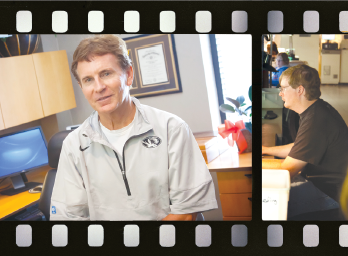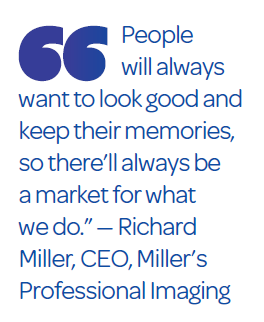Inside the Mpix Empire

THE LITTLE WHITE CURSER sweeps over Mom’s face on the 20-inch monitor in a dark corner of the Miller’s Professional Imaging lab in Columbia. The wrinkles smooth out, and the tiredness is wiped from her face. In less than 20 seconds, she looks 10 years younger and happier for all of her friends and family who will receive this Christmas card in a couple of weeks. The glare on her daughter’s glasses is removed with another sweep of the mouse on Jessica Wells’ computer screen.
“I can also take off braces,” Wells says. Mouse in hand, she flicks through the library of teeth she’s collected during the seven years she’s worked in the photo-finishing department at Miller’s. The lab smells like fresh ink and warm plastic, and the hum of dozens of machines is constant. There’s a long line of bins full of holiday orders ready to ship across the country.
Each December, consumers send hundreds of holiday cards and give books cataloging another year’s worth of memories to loved ones. This time of year, Miller’s production is three times that of slower months.
The company, which started in Pittsburg, Kan., in 1939 with founder Bill Miller’s small photography studio, is currently the largest pro-photo lab in the United States. With a 123,000-square-foot lab and 360 employees still in Kansas, Miller’s added a second facility, standing at 44,000 square feet and employing more than 180 people, in Columbia in 2001.
That was also the peak year for film photography. During the next 11 years, more than 99 percent of Miller’s business would disappear as digital cameras came to dominate the industry.
Balancing a changing industry
Richard Miller is the CEO of Miller’s Professional Imaging. His Mizzou-themed office has no less than three tiger statues, five footballs and three basketballs. He estimates that nine out of 10 competitors didn’t survive the transition to digital.
Although the number of photos taken each year has skyrocketed from 86 billion in 2000 to 380 billion in 2011, digital photography presented a great challenge to the industry.
“What’s challenging is that people aren’t printing pictures,” Miller says. “For example, when kids go to prom, by the time they get there, the parents have taken so many photos that there’s no need for a professional photographer.” Those photos live in photo libraries on computers and on Facebook, CDs and in digital picture frames and are sent from camera phone to camera phone. They’re shared and enjoyed but unprinted.

Although the photo-finishing industry, the bulk of Miller’s original work, has shrunk by 5 percent each year for five years, the online photo-printing industry has grown an average of 21 percent each year during the same period.
Miller’s has achieved notoriety in the rapidly growing online printing arena with Mpix, created in 2003 and marketed as affordable, quality photo printing for everyone. Now, business is divided almost evenly between Mpix for general consumers and Miller’s traditional services for professionals, and the business employed 486 people between the two facilities during the 2011 holidays.
“We need to keep people aware of the benefits of high-quality photography, but it’s like moving grains of sand along the beach,” Miller says. Miller, like his father was before him, is a photographer himself, and he says that was obviously a great prerequisite for understanding his customers. Before becoming president in 1976, he had worked at the business from the time he was 16. After graduating from the University of Missouri, he typically worked 80-hour weeks for little more than $1 per hour.
Miller now acts as CEO, and his nephew Todd Coleman is the president and chief operating officer. Miller says much of the business’ current success can be credited to Coleman and his father, Dick Coleman, who serves as vice president, and Marcia Sorrick, chief financial officer.
Embracing the future
When Miller entered the business in 1971, he had big changes in mind, changes that didn’t initially excite his father. “In my dad’s time, Kodak was king, and he believed everything they said,” Miller says.
But when Miller tripled the company’s sales in the first two years, his father accepted the innovation. Forty years later, Kodak declared bankruptcy.
The fall of the giant was the final crumbling block of the old photo industry, and Miller’s has fully embraced the future. Miller says his company’s impressive growth can be attributed to three things: innovation, organization and the company culture.
“People will always want things for their walls and desks,” he says. “The photo business is even bigger than before; it’s just different.” Miller saw the change coming and began to manipulate digital images in 1990, well before the advent of the digital camera.
Without a sales force, the company has also found innovative ways to reach consumers. Because a Super Bowl ad is out of Miller’s price budget, Miller says, the company is focusing on viral marketing. Social media giveaways and coupons, along with a continual rollout of new products, continue to attract customers.
Miller’s has expanded its services far beyond ink on paper. Now, prom pictures can be printed on anything, from a mug to a keepsake ornament or memory box. About 60 percent of Miller’s business is photo on paper, and the rest incorporates the newer custom options. And all items can be delivered the next day.
Miller has incorporated a monitoring system to ensure the company’s next-day track record as well as to keep an eye on accuracy and performance. The plastic folder of colorful charts is the first thing Miller looks at each morning.
“One of my team members asked me once why I don’t smile, and I told her I only smile when the numbers look good,” Miller says jokingly. “Anyone can [monitor the stats]. The difference is what you do with that information.”
It’s an organizational method Miller also impresses upon his employees. Each department has a bulletin board exposing the same charts, and most departments have weekly, if not daily, meetings to discuss the numbers.
Another chart that is equally important to employees is the profit-sharing chart. In addition to regular salaries, Miller’s employees made almost 70 percent more last year through the profit-sharing program. For example, someone earning $20,000 would earn an additional $14,000 in profit sharing.
“You can see the smiles go around the office when the profit-sharing numbers are sent out,” says Tracy Eichhorn, a Miller’s employee for 18 years. Miller says he believes this encourages the team to be more conscientious of the company’s bottom line because it’s their bottom line, too.
“If there’ s a return for a mistake, they know it’s coming out of their pocket in the end, “ Miller says.
Perfecting the business
Perfection is part of the culture at Miller’s. Employees are expected to do whatever it takes to make the customer happy and put the company first, especially during the holiday rush. When Miller first took over the business, people were always telling him he was aiming too high and expecting too much, but he is a self-proclaimed perfectionist. “If you don’t expect [perfection], then you’ll never get it,” he says.
When Miller’s opened its Columbia facility, it brought 30 people over from its Pittsburg facility. Eichhorn was one of those employees tasked to introduce the company culture from Pittsburg to the new facility. Having worked her way up from the production floor to human resources manager, she’s developed a speech for prospective employees to promote the culture Miller’s has been so careful to develop and preserve.
“In the last quarter of the year, we all basically live here for four or five weeks, working 12-hour days,” Eichhorn says. “We’ve got to get people who will give everything they have to Miller’s.”
After all the work, Miller says there’s always a big holiday party. “Around Christmas, our employees are earning lots of overtime and big profit-sharing checks, and they have no time to spend money, so after the rush, they have a nice chunk of change,” he says. Last year during the holiday rush, Eichhorn, along with many of the other office employees, went out to the plant to get orders shipped on time.
“I was out there tying bows in the packaging department, and the department leader kept sending my boxes back because I wasn’t doing it right,” she says. Each of those ribbon-wrapped boxes, after a couple tries, is placed in the long line of bins full of holiday shipments. Nothing seen in the window-walled Miller’s factory shows signs of a declining industry, and Miller knows that.
“People will always want to look good and keep their memories, so there’ll always be a market for what we do,” he says.


